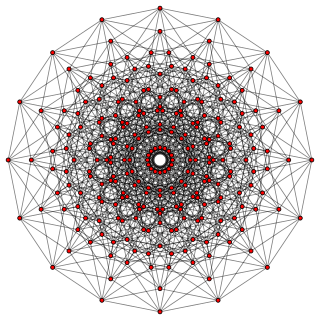Top Qs
Timeline
Chat
Perspective
8-cube
8-dimensional hypercube From Wikipedia, the free encyclopedia
Remove ads
In geometry, an 8-cube is an eight-dimensional hypercube. It has 256 vertices, 1024 edges, 1792 square faces, 1792 cubic cells, 1120 tesseract 4-faces, 448 5-cube 5-faces, 112 6-cube 6-faces, and 16 7-cube 7-faces.
It is represented by Schläfli symbol {4,36}, being composed of 3 7-cubes around each 6-face. It is called an octeract, a portmanteau of tesseract (the 4-cube) and oct for eight (dimensions) in Greek. It can also be called a regular hexadeca-8-tope or hexadecazetton, being an 8-dimensional polytope constructed from 16 regular facets.
It is a part of an infinite family of polytopes, called hypercubes. The dual of an 8-cube can be called an 8-orthoplex and is a part of the infinite family of cross-polytopes.
Remove ads
Cartesian coordinates
Cartesian coordinates for the vertices of an 8-cube centered at the origin and edge length 2 are
- (±1,±1,±1,±1,±1,±1,±1,±1)
while the interior of the same consists of all points (x0, x1, x2, x3, x4, x5, x6, x7) with −1 < xi < 1.
As a configuration
Summarize
Perspective
This configuration matrix represents the 8-cube. The rows and columns correspond to vertices, edges, faces, cells, 4-faces, 5-faces, 6-faces, and 7-faces. The diagonal numbers say how many of each element occur in the whole 8-cube. The nondiagonal numbers say how many of the column's element occur in or at the row's element.[1][2]
The diagonal f-vector numbers are derived through the Wythoff construction, dividing the full group order of a subgroup order by removing one mirror at a time.[3]
Remove ads
Projections
 This 8-cube graph is an orthogonal projection. This orientation shows columns of vertices positioned a vertex-edge-vertex distance from one vertex on the left to one vertex on the right, and edges attaching adjacent columns of vertices. The number of vertices in each column represents rows in Pascal's triangle, being 1:8:28:56:70:56:28:8:1. |
Derived polytopes
Applying an alternation operation, deleting alternating vertices of the octeract, creates another uniform polytope, called an 8-demicube, (part of an infinite family called demihypercubes), which has 16 demihepteractic and 128 8-simplex facets.
Related polytopes
The 8-cube is 8th in an infinite series of hypercube:
 |
 |
 |
 |
 |
 |
 |
 |
 |
 |
| Line segment | Square | Cube | 4-cube | 5-cube | 6-cube | 7-cube | 8-cube | 9-cube | 10-cube |
References
External links
Wikiwand - on
Seamless Wikipedia browsing. On steroids.
Remove ads












